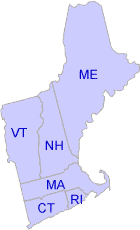Nonpoint Source (Polluted Runoff) Water Pollution in New England - Region 1
EPA Region 1 serves Connecticut, Maine, Massachusetts, New Hampshire, Rhode Island, Vermont and 10 tribal nations.
Basic Information
- What is Nonpoint Source (NPS) Pollution?
- What are the Types of Nonpoint Source Pollution?
- NPS Grant Program for States and Territories
Region 1 HOT Topics
- Updated New England States' Nonpoint Source Management Program Plans
- Nonpoint Source Program and Grants Guidelines for States and Territories (pdf)
- Restoring Nonpoint Source Polluted Waters (2002-2018): Region 1 NPS success story map (pdf)
- Celebrating New England's Tribal 319 Nonpoint Source Program Efforts: Tribal Nations' Success Story Presentation (pdf)
Find Specific NPS Projects and Watershed-Based Plans
Other NPS Information
- Find a State NPS Management Plan (select Region "01")
- Polluted Runoff: NPS Pollution Home
- Tribal Nonpoint Source Program
- Technical Guidance and Tools
- NPS Program Guidance (2013) (pdf)
- NPS Success Stories
- GRTS NPS Database
- How's My Waterway?
Additional Region 1 Information
- Region 1 EPA Nonpoint Source Program Contacts
- Region 1 States' Nonpoint Source Program Contacts (select Region "01")
![Illustration: What is a watershed? [Credit: The Center for Watershed Protection]](/system/files/styles/medium/private/images/2023-09/cwp-watershed.png?itok=iGXtC0rL)
[Credit: The Center for Watershed Protection]
Nonpoint source pollution (NPS), also known as polluted runoff, is caused by rainfall or snowmelt moving over or through the ground. As the runoff moves, it picks up and carries away natural and human-made pollutants, finally depositing them into lakes, rivers, wetlands, and coastal waters.
Because it is a diffuse source, underground pollution from poorly performing septic systems is also included.

